Vaisakhi Celebration in Hounslow
Hounslow, Middx. 30 March, 2008
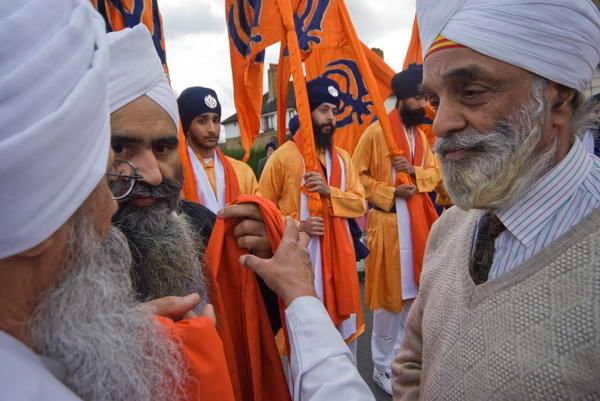
Sunday's Vaisakhi procession was full of colour and life and had more than
the usual interest for me. I grew up in Hounslow and my first full-time
job was in a dye-stuffs lab where the Gurdwara Sri Guru Singh Sabha now
stands, a short walk from where I spent most of my first 18 years. Quite a
few of the workers there were Sikhs, and often their clothing and skin was
highly coloured by the intensely coloured powders they were producing and
packing in what would in these different days be seen as a health and
safety nightmare.
I've written before about the celebration of Vaisakhi and you can read
more about it and see some of my earlier pictures from various Nagar
Kirtan (Sikh processions) here in 2004,
2005, 2006
and 2007.
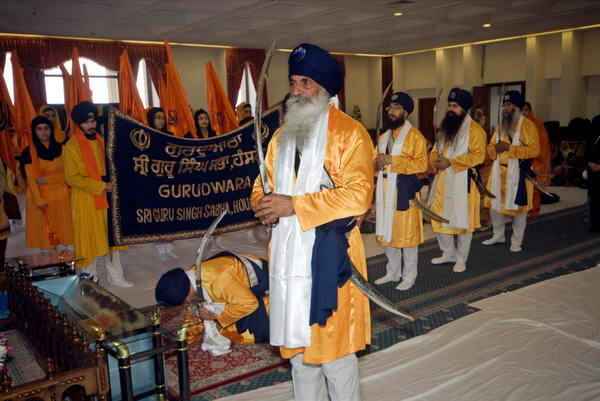
As well as the colour, what also stands out for me is the friendliness
of all of the Sikhs who welcomed me and let me photograph the day's
events - and of the many individuals whose pictures I took.
Before the procession I photographed some of the preparations and the
events inside the Gurdwara. As usual the kitchen was busy and
purposeful, people working as a team in preparing food for the people
(which unfortunately I didn't have time to try, but it looked good.) The
ceremonies in the prayer hall have a remarkable dignity and warmth
although I can't understand the language.
The procession out of the worship hall included the Sikh Holy book, the
Guru Granth Sahib, carried with great respect on a cushion on someone's
head and then installed on the the Palki truck. The Palki is a canopy
over Holy book, which is placed on a raised dais (Manji Sahib), covered
by a decorative cloth (Romala) and surrounded by flowers.
The procession was led by the Nagara, a large drum beaten with
considerable force (originally used to celebrate victory in battles)
which was followed by the Gurdwara banner. There were two rows of Sikh
women carrying Sikh flags (saffron with the Sikh Khanda symbol, followed
by 5 Sikh men with flags and then the Panj Pyaras (the five beloved
ones) with their swords held upright, walking directly in front of the
lorry carrying the Guru Granth Sahib.
Following walk the many worshippers (Sangat) taking part in the Nagar
Kirtan, along with vehicles carrying the older and infirm members of the
community. Many join the procession along the route, while others set up
stalls to offer free food and drink to all those taking part.
With the procession I walked along streets that were once familiar to
me, although many local landmarks have disappeared (to be replaced my
ugly commercial developments - for which the Treaty Centre deserves some
kind of wooden spoon award - and it replaced an architecturally fine
Victorian civic complex of town hall, library and public baths), and
much has been sacrificed to the car.
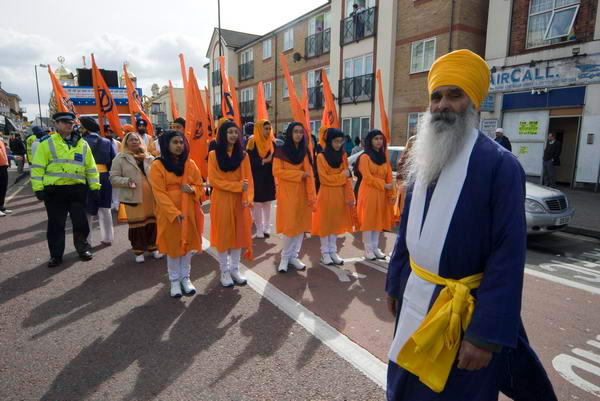
Walking down the Bath Road, I failed to locate my own first school,
Major Drake Brockman's Academy, from which I was expelled aged 4. The
clinic where I went in my pram for orange juice and cod liver oil has
been replaced by a modern health centre (a better fate than the nearby
hospital, now sheds for electrical goods and car and leisure products.)
One thing that was only too obvious was aircraft noise, with a constant
procession of low-flying aircraft over our heads as we walked, and a
reminder of the nightmares about aircraft in flames and crashes I used
to have, prompted by real events watched from my Hounslow back yard.
The procession led down Martindale Road, past the school my father left
in 1913 (though he wouldn't recognise it now) and on to the Gurdwara
Guru Nanak Nishkam Sewak Jatha, outside which the procession halted.
Here orange sashes were presented and put around the head of the Sikhs
carrying the flags, the Panj Piaras and some of the others taking part.
The procession then carried on to return to the Gurdwara in Alice Way
where it started. But I had to go in the other direction to catch my bus
home.
more pictures
Stepping Out for Water
Laleham Church - Staines, Middx. Saturday 29 March, 2008
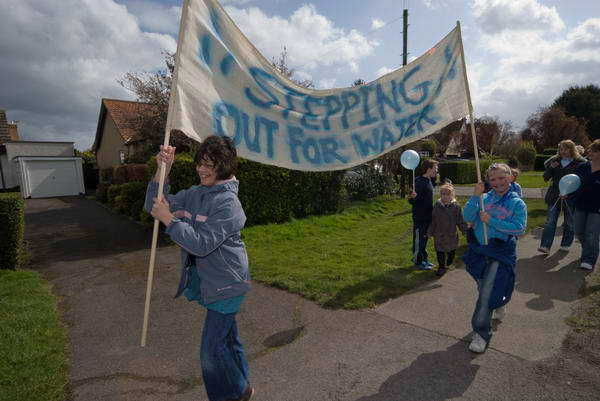
Marchers on Staines Road, Laleham with the
Stepping out for Water banner.
more pictures
Demonstrations are pretty rare in Spelthorne, though nearby Heathrow
seems likely to become a considerable epicentre unless the government
decides the environment really does deserve more than lip-service and
cancels the plans for a third runway there. But today's 'Stepping Out
for Water' event was certainly appropriate, for the area - like the
planet as a whole - is about two thirds covered by the stuff, in rivers,
reservoirs and unfilled gravel pits (probably the council prefers to
think of these as leisure facilities.)
But this was a march about the one fifth of the world who lack clean
water and the 40% who lack basic sanitation. In 2000, 189 nations
committed themselves to the Millennium Development Goals, No. 7 of which
included the aim to halve those without clean water and sanitation by
2015.
Promises were easy to make, but at current rates will fall very much
short of this aim - some 600 million people short. More action is
needed, and the aim of this walk from All Saints' Church Laleham
to Staines - chosen as it is a typical distance that people have to walk
for their water in Africa - was to add to pressure on our politicians
and government to get things done. Similar events have been organised
elsewhere in the world, for example by WaterAid in Australia, and other
events took place in the UK, particularly linked to World Water Day, a
week ago on March 22, 2008.
People in the march wore blue, not unusually for Spelthorne, a
dedicated part of the Tory homeland. Less usually they carried buckets,
mainly empty, as those who daily walk to collect their water do, and
walked down Staines High Street with them on their heads.
The march ended on the grass area by the river between Staines
Methodist Church and the Riverside Car Park, where the children who took
part found a 'water feature' installed by the council to play around.
There were speeches by Claire who had organised the event, as well as by
Spelthorne MP David Wilshire, and the event ended with a prayer.
Defend Press Freedom - Support Photographers
New Scotland Yard, London. Friday 28 March, 2008

Jeremy Dear demonstrating outside New Scotland Yard
more pictures
NUJ General Secretary Jeremy Dear mounted a one-person demonstration
outside New Scotland Yard in support of photographers who want police to
work to the agreed guidelines and respect the rights of the press when
policing demonstrations. Around 20 photographers who regularly cover
such events - most, but not all NUJ members - turned up to photograph
him and show their support for the demonstration. You can read more
about the issues and the event in the >Re:PHOTO blog post 'Photographers
by the Yard.
more pictures
Aldermaston - 50 years
Aldermaston, Berks. Monday 24 March, 2008
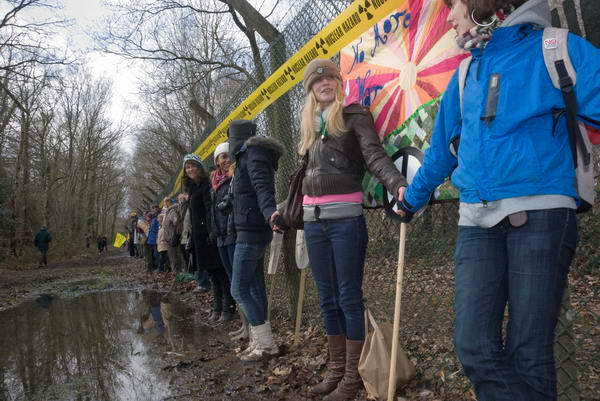
Holding hands around the base
more pictures
Monday I got up too late to join the Bikes Not Bombs cyclists
on their way from Reading, where I arrived by train. The train that goes
from Staines to Reading is so so slow I'm convinced there is still a man
with a red flag walking in front of it much of the way, and the 20 or so
miles took almost an hour.
I took exactly the same route from Reading that I'd walked with Pat
Arrowsmith and the other Aldermaston marchers in the 2004
march. Although a cool day, it was a pleasant morning for riding
and I was quite enjoying it until a stretch of road called 'Hermit's
Hill' reminded me how out of practice I was at cycling. I can't remember
when I last had to push my bike up a hill, although in 2002 when my
arteries were almost fully clogged with cholesterol I did once have to
stop and rest in Normandy. Fortunately it turned out to be the only
significant hill on the route.
I went first to the main gate and joined the other photographers who
were there, and took a few pictures of people arriving, including the 30
or so cyclists who I had beaten there. I walked down with some of the
other photographers to the Falcon gate, but not a lot was happening
there.
Later I took a ride around perimeter, or at least the part of it which
is on roads - the northern side is simply a footpath, and it was rather
muddy and full of demonstrators, so I didn't try to ride along it. I
caught up with the cyclists again at the Boiler House gate where I
stopped to take some pictures, as quite a lot seemed to be happening
there. They left before I had taken all the pictures that I wanted, and
got a few minutes start on me, before I pedalled off in pursuit. The
road leads down and through the actual village of Aldermaston (rich home
counties, rather too tidy), but what goes down has to come up, and I
found myself struggling uphill again through the queue of traffic held
up by the 'bikes not bombs' group and their police escort of two cars
and several motorbikes.
The Construction gate at the top of the hill had a Welsh socialist
choir, and I took a few pictures before I saw the cyclists coming up
again - they had stopped to regroup a little down the road. Further
along the fence, near the Home Office Gate was another largish group of
people and a veteran from 1958 was talking. The incredible Rinky-Dink
mobile cycle-powered sound system was also there - another reminder of
2004 when it accompanied us as we marched down the lanes to the base.
People were now beginning to link hands around the base, although the
organisers had talked about one person every 5 metres. Most of it seemed
to be surrounded considerably more densely than this, although there
were some gaps.
Back at the main gate there was an opportunity to photograph some of
the speakers who were touring the event, although I didn't actually hear
them speak. They included two labour MPs, Jeremy Corbyn and John
McDonnell, Green MEP Caroline Lucas, veteran Labour Party member Walter
Wolfgang and several guests from Japan, one of whom was a survivor from
Hiroshima.
After that people started to go home, and after a short but rather
heavy shower I decided it was time to get on my bike too.
more pictures
Flash Mob Global Pillow Fight - London
Leicester Square, London. Saturday 22 March, 2008
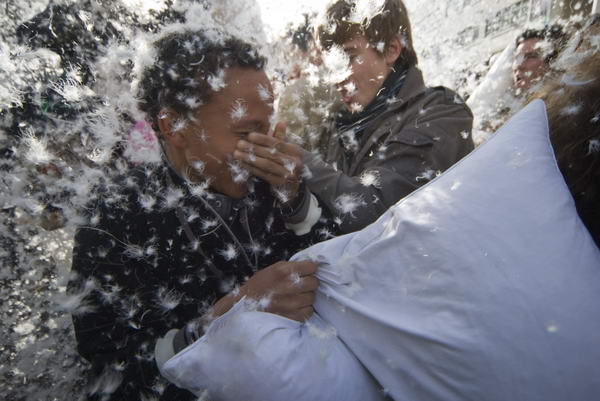
Quite a few pillows tore, filling the air with
feathers
more pictures
I left the Whitehall demonstration early to rush to Leicester Square
for 3pm, as the first of a series of pillow fights in capitals around
the world was due to kick off at 15.03, although in the event it started
a little earlier.
Of course its a trivial, silly event, but the idea and the kind of
organisation involved I think represents something new and exciting, a
kind of 'Demo 2.0' which we will surely see more of in the future.
It's another example of the kind of on-line organisation that we saw
put to a rather more serious purpose in the world-wide protests against
the 'Church of Scientology' last month by 'Anonymous'.
There were several hundred people with pillows in the north area of the
square belting each other around the head with them and having a great
time doing so. Being a photographer in the middle of it all was
occasionally a little worrying, as although the odd wildly aimed pillow
was unlikely to hurt me, cameras and flash units are just a little more
sensitive.
The greatest danger to my health wasn't from impact but suffocation
when some pillows split open to fill the air with clouds of feathers and
feather-dust. At times I wished I was wearing a mask to protect my
lungs; keeping my mouth firmly closed and breathing though my nose only
stopped the larger particles.
Planes in battle during the Second World War dropped strips of 'window'
(aluminium foil strips) as chaff to jam the radar tracking them. I
discovered that dense clouds of duck feathers have a similar effect on
autofocus systems and flash. Until I had the sense to switch to manual
focus my camera simply failed to focus in the denser areas and I missed
out on photographing some of the most visually powerful scenes.
Unfortunately later pillow splits were considerably less dramatic, at
least from my position.
It was an example of a situation where the view outside the frame area
of a rangefinder camera would have been extremely useful. With an SLR, I
try to keep the eye not at the viewfinder looking at the scene, but it
isn't quite the same, and when chaos really rules taking pictures
becomes a press and hope situation. I think some of them do give an idea
of what it was like to be there
more pictures
Defend Mehdi Kazemi
Downing St, London. Saturday 22 March, 2008
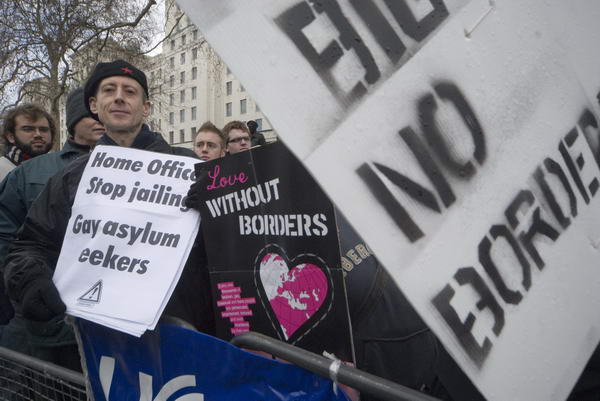
Peter Tatchell holds a poster opposite Downing St
more pictures
Despite a biting wind, rain and at one point a fortunately very short
blizzard that reduced visibility so it became impossible to see across
Whitehall, there were around 150 demonstrators present to support the
protest against the deportation of Mehdi Kazemi.
Kazemi has been refused permission to stay in Britain; in Iran, where
he is due to be deported by the UK government, homosexuality is a crime
punishable by death, and one for which the regime have already executed
his boyfriend.
The demonstration was sponsored by Middle East Workers' Solidarity
and the National Union of Students LGBT campaign,
and was supported by other groups including OutRage! and Hands
off the People of Iran.
As the speakers reminded us, Kazemi's is by far from being the only
case where the UK Home Office's attitude to LGBT refugees and asylum
seekers is failing.
Peter Tatchell of Outrage! highlighted the need for training
on sexual orientation issues for staff dealing with asylum issues and
for an explicit policy which supports the right of refugees to claim
asylum on the grounds of persecution because of their sexual
orientation. He also deplored the lack of action to stamp out the abuse
of LGBT refugees in the UK asylum system and for appropriate legal
representation for LGBT asylum applicants, as well as the failure of the
government to collect accurate and up-to-date information on homophobic
persecution in countries to which LGBT asylum seekers might be deported.
Several speakers commented critically on George Galloway's apologies
and lies about the homophobic Iranian regime and his attacks on Peter
Tatchell for exposing its activities.
more pictures
Support Tibet March
Park Crescent - Trafalgar Square, London. Sat March 22, 2008
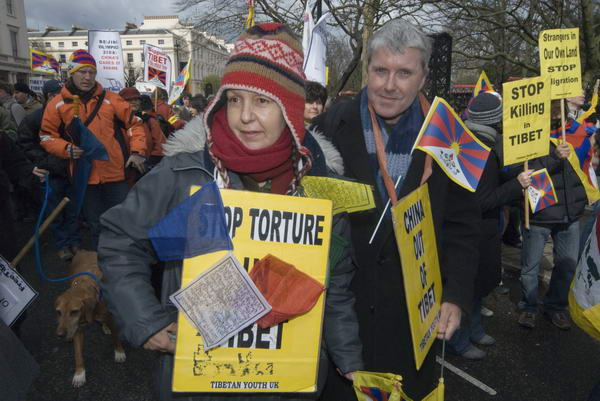
Waiting for the start of the march in Park Crescent
more pictures
Around 500 people, including many Tibetans, assembled in Park Crescent
on Saturday morning, a short distance north of the Chinese Embassy.
Tibetans and supporters of freedom in Tibet were marching through London
again in support of the struggle for human rights following the brutal
Chinese repression of the demonstrations and marches in Lhasa and
elsewhere celebrating the 49th anniversary of the Tibetan uprising.
After events
earlier in the week there was a strong police presence, especially
around the Chinese Embassy in Portland Place, where the march halted
briefly and many shouted in its direction for freedom for Tibet and
shame on the Chinese for their human rights abuses.. The police soon
urged marchers on and there were no incidents there. As usual the FIT
were there and everyone and his dog where having their portraits made.
As the march walked through the busy shopping streets of the West End
there were many expressions of support, although one person who put up a
show of opposition was quickly surrounded by police. For most of its
route the march was led by four Drapchi nuns and a monk carrying a
portrait of the Dalai Lama.
There were occasional flurries of hail and showers during the march,
and a few seconds of blizzard as we went down Regent Street, weather
that made it feel a little more like Tibet than London.
The crowd was a little larger by the time we reached the north terrace
at Trafalgar Square, where there was a short rally. Among the speakers
was MP Kate Hooey, who urged us all to lobby our MPs, and particularly
to ask that they sign Early Day Motion 1201 which condemns the Chinese
authorities and calls on the government to denounce their actions,
support a UN inquiry and urge the Chinese to negotiate with the Dalai
Lama. (It also asks for the Prime Minister to meet the Dalai Lama when
he visits Britain - which George Brown has now confirmed he will.)
Speakers also called for a boycott of the opening ceremony at the
Olympic games by UK government officials and dignitaries in protest at
the repression and lack of human rights in Tibet, as well as for
pressure to be exerted to alter the route of the Olympic flame to keep
it out of Tibet - and in particular away from Lhasa and Mount Everest.
Those who had taken part in the hunger strike this week were applauded
and presented with white sashes, and some of them also spoke before the
meeting ended.
more pictures
Bikes Not Bombs - London to Aldermaston
Oxford St, London. Saturday 22 March, 2008
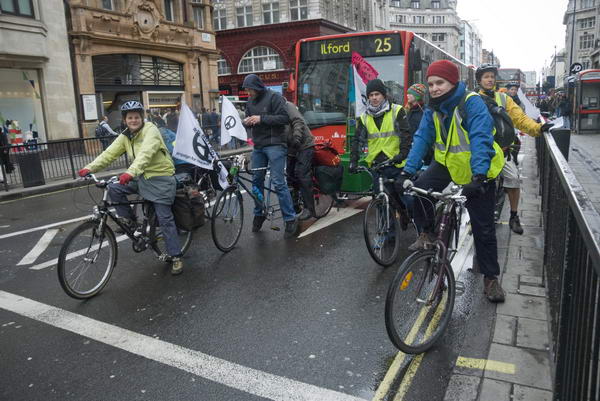
I had hoped to cycle part of the way from London to Aldermaston with Bikes
Not Bombs, but for various reasons (sloth, other events, lousy
weather and a dislike of early rising) it didn't happen. In the end I
did ride from Reading to Aldermaston (and back) on Monday, but started
and hour or two later than the organised ride, taking a more direct
route at a faster pace.
Although I wasn't there at Trafalgar Square to see them off on
Saturday, I did come across them a little later, as they cycled east
along Oxford Street past Oxford Circus, in exactly the opposite
direction that would have taken them towards Aldermaston.
Of course this wasn't a cycle rally, but a demonstration, and a start
by making a little noise (or rather mainly music from the tandem-hauled
sound system) and getting noticed in London's busiest shopping streets
made absolute sense.
more pictures
Gaura Purnima Festival - Hare Krishna
West End, London. Friday 21 March, 2008
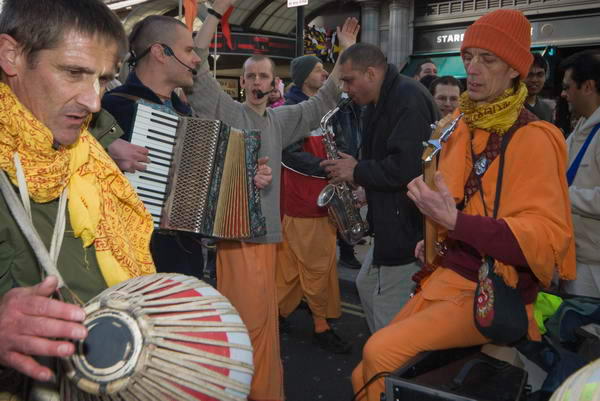 Hare
Krishna musicians in Leicester Square
Hare
Krishna musicians in Leicester Square
more pictures
My final religious event on Friday was with the Hare Krishna
(International Society for Krishna Consciousness), whose Gaura Purnima
(Golden Full Moon) festival celebrates the appearance of the Lord
Caitanya just over five hundred years ago in West Bengal.
It was Caitanya, also known as the Great Master (Mahaprabhu), who was
Krishna appearing as a pure devotee of himself, who encouraged everyone
to dance and chant the holy names of Krishna. On Gaura Purnima his
followers sing and chant there way around the centre of London, fasting
all day until moonrise, when they enjoy a sumptuous feast together.
more pictures
Purim Fun Bus
Golders Green, London. March 21, 2008
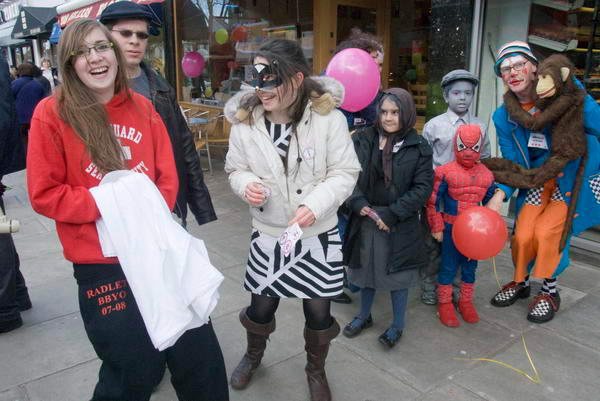
Next to the Camp Simcha Purim Fun Bus in Golders Green
more pictures
From Waterloo I went to Golders Green, where the Jewish festival of Purim
was being celebrated on the street. When the Jews were in exile in
Babylon, Esther, who had been made Queen by the ruler Xerxes,
along with her cousin and former guardian Mordechai who was the palace
gatekeeper foiled the wicked plans of the royal vizier Harman to kill
the Jews.
Traditionally Jews wear fancy dress to celebrate and make a lot of
noise to drown out the name of the evil Haman when the story from the
Torah is read in synagogue on Purim. They also eat special triangular
cakes full of poppy seeds called 'Haman's Ears', and children in fancy
dress sometimes take these as gifts to their neighbours.
Camp Simcha, a charity which provides support for Jewish
children with serious illnesses and their families, had organised two
Purim fun buses in Golders Green and Hendon, providing fun activities
for children and raising money. Together with three other photographers
I spent half an hour or so photographing around the bus in Golders
Green.
more pictures
Good Friday Walk of Witness - North Lambeth
St John's Waterloo & Waterloo Station, London. March 21, 2008
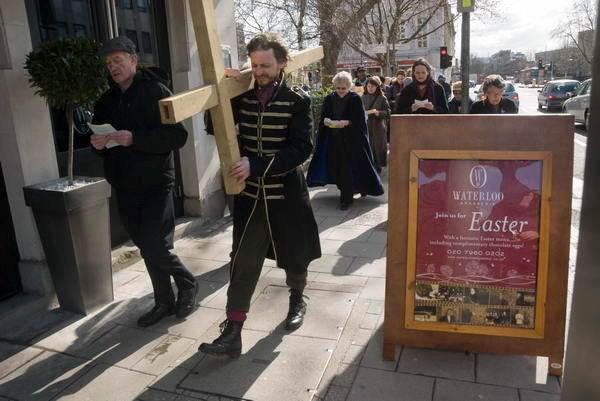
"Join us for Easter", Waterloo Road
more pictures
Friday was a very religious day. It was of course Good Friday
for Christians, and I went with a procession starting from St
John's Church opposite Waterloo station, which went around the
area, stopping outside St Patrick's Catholic Schools and calling in
briefly at the rather more recent building of St Andrew's in
Short Street, off The Cut, before some hymns and prayers on the square
opposite the Old Vic. The walk ended with a longer service on the
forecourt of Waterloo Station, where they were joined by another group
who had started their procession at the Imperial War Museum (see Good
Friday last year.)
more pictures
Druid Order - Spring Equinox
Tower Hill, London. March 20 2008
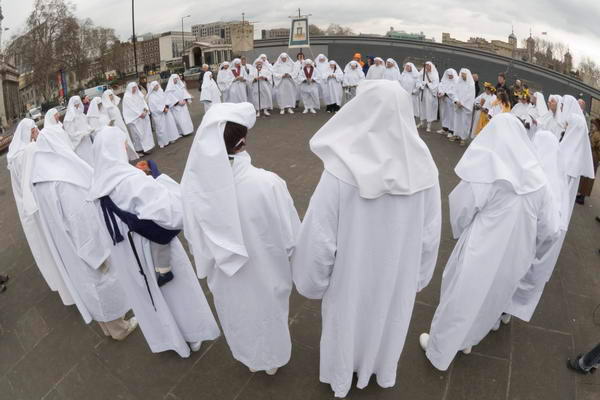
The circle of druids on Tower Hill
more pictures
It may have been the start of spring, but it felt more like winter, and
there was a biting wind across the open space at Tower Hill for the
Druid Spring Equinox Ceremony, and as it came to an end, cold rain drove
into us.
The horn was sounded to the four corners, and then the sword was
raised, and it was peace from the North, South, West and East. The Earth
Mother, Ceridwen and her attendants brought a horn for a libation, seeds
to scatter and flowers into the circle, and those departed were
remembered.
After the ceremony the druids filed off through the pathways around
Tower Hill into the streets of London.
more pictures
Tibet Vigil at Chinese Embassy
Portland Place, London. 17 March 2008
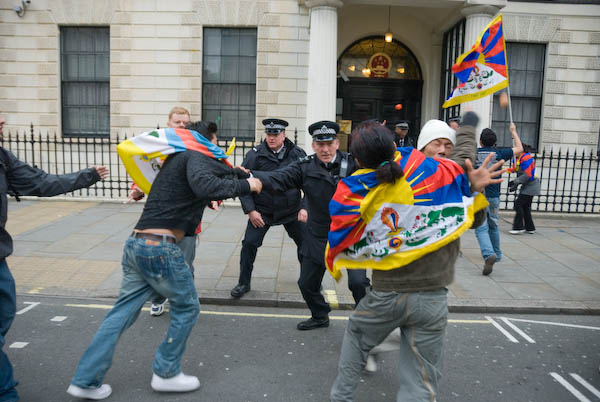 Protesters run across the road and make for the
Chinese Embassy carrying Tibetan flags, as police and two stewards try
to stop them. I'm right behind them with a wide-angle lens.
Protesters run across the road and make for the
Chinese Embassy carrying Tibetan flags, as police and two stewards try
to stop them. I'm right behind them with a wide-angle lens.
more pictures
According to the Chinese Authorities, they "exercised restraint"
in dealing with the Lhasa protests, using only non-lethal weapons and only
killing 13 innocent civilians. Monday afternoon’s demonstration in
Portland Place opposite the Chinese Embassy was timed to coincide with
the midnight deadline in Lhasa for protesters to surrender.
For the hour or so I was in Portland Place, the Met put on a
considerably more convincing display of restraint, with the help of the
'Free Tibet' stewards, causing – so far as I saw - nothing
worse than a few minor bruises. British police at least sometimes live
up to their reputation, although perhaps a double row of barriers would
have been a sensible precaution.
When I arrived at Portland Place around 4.30, around 200 demonstrators
were penned behind a single row of barriers along the edge of the road
in front of the RIBA building. Three policemen stood in front of the
demonstrators who were shouting slogans towards the Chinese embassy
across the road. The media were refused access to photograph from the
empty area in front of these barriers, although a row of press here
would almost certainly have aided security, but they were allowed into
the island – also surrounded by barriers – in the centre of the road. Of
course this was too far distant for decent pictures, and I started by
photographing in the pen with the protesters.
I was just crossing the road around 5pm when a demonstrator jumped the
line and ran across towards the embassy waving a Tibetan flag - where
the four officers on duty immediately grabbed him. Other demonstrators
pushed the barriers down and followed him, and so did I, taking pictures
with a wide-angle.
The next few minutes reminded me of one of those traditional village
football matches, or those games of 'British Bulldog' we used to play
before such things were banned, as police and stewards grappled with
demonstrators. Finally the stewards took over and pushed and persuaded
them across the roadway to the central island where they sat down. I saw
no instances of excessive violence being used by police, and those of us
reporting the incident all appeared to be well treated despite a fairly
confusing situation.
The demonstrators continued to shout at the Chinese Embassy from the
central island for around ten minutes. A police officer then read
something out to them, which I'm doubt they could hear any more clearly
than I could above the noise. I suspect they were being threatened with
arrest if they stayed where they were, but I couldn’t hear well enough
to tell under which Act. With the help of the stewards they were then
all escorted back across the road to join the other demonstrators who
had stayed in place
more pictures
Brent St Patrick's Day Parade
Willesden Green, London, March 17, 2008
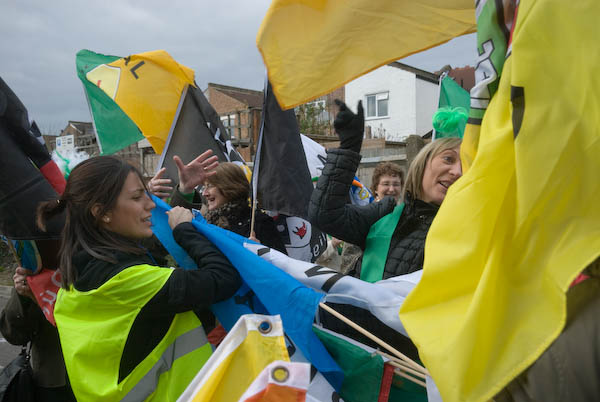 Sorting
out the Irish county flags
Sorting
out the Irish county flags
more pictures
Brent in the northwest of London is possibly the only London borough
that has its own St Patrick's Day parade (the borough also celebrates
Diwali, Eid, Christmas, Chanukah and Navrati, and Holocaust Memorial
Day, along with a black history programme, its own 'Respect' festival
and a world food and music festival.)
The St Patrick's Day parade actually starts from an Islamic Centre
close to Willesden Green centre and makes its way to the library in High
Road Willesden where there are various musical performances and a bit of
a funfair.
This year the parade was held on St Pat's day itself, which was a
Monday, and perhaps because of this seemed a considerably smaller event
than last year.
more pictures
Protest Brings Pipeline to Shell
Waterloo, London. March 17, 2008
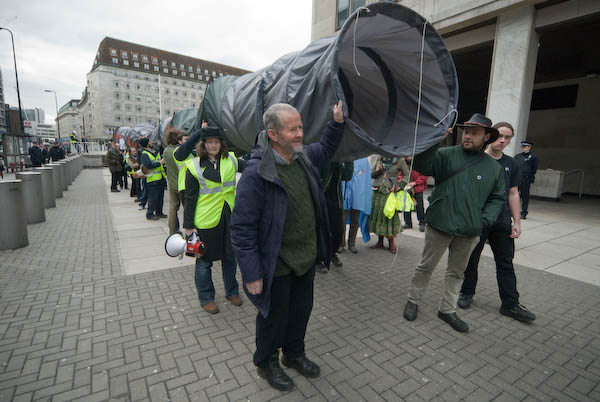
The giant pipeline outside the Shell building on
York Road
more pictures
All-Irish environmental and social justice movement Gluaiseacht
were in London for the weekend, and on St Patrick's Day itself gathered
outside the Shell HQ at Waterloo, bringing with them a very large
pipeline.
The protest was over the Corrib Gas Project in Mayo in the
north-west of Ireland, which the Irish Government has given at a
knock-down price to Shell, Statoil and Marathon.
It’s a project estimated to be worth over 50 billion Euros, but the
Irish people will hardly benefit from the profits - and Shell gets the
largest share.
Even worse the people in Mayo will suffer from the pollution around an
inland refinery and a high pressure pipeline that will endanger local
communities. Protests in Ireland have led to innocent people being
jailed.
Around 30 Irish protesters along with local supporters held a
good-natured and lively protest, with a great deal of singing and
dancing as well as that giant pipeline, watched by a number of Shell
security men and a small group of police - including FIT and the
inevitable photographer.
more pictures
Stop the War/CND/BMI - Troops out
Trafalgar Square - Parliament Square, London. Sat 15 March, 2008
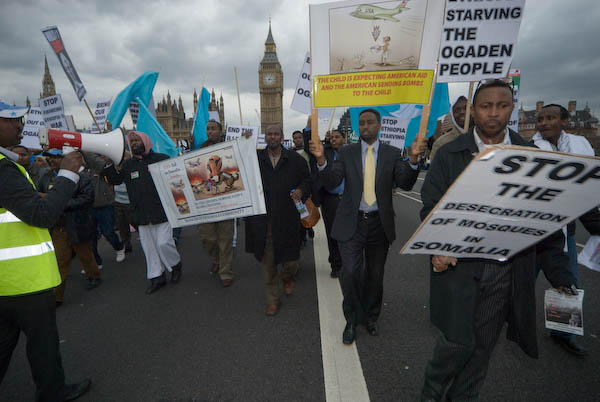 Somalis
added their protest to the event, which also called for Israel to get
out of Gaza
Somalis
added their protest to the event, which also called for Israel to get
out of Gaza
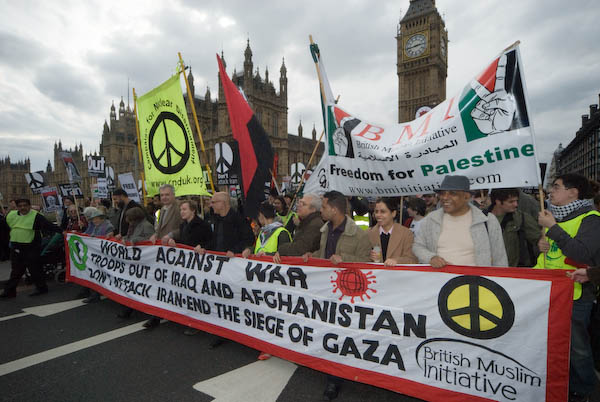
The front of the march on Westminster Bridge
more pictures
Around 50,000 turned up for the march, which began with a rally in
Trafalgar Square, which was addressed by speakers including Tony Benn
and Bruce Kent. Police FIT teams were out in force and spent most of
their time hovering around the two small groups of anarchists from
'Class War' and 'FITwatch', although some young Muslim men also seemed
to attract their interest.
I wasn't around when they arrested four of the FITwatch protesters,
apparently on the grounds that the police had felt intimidated by their
actions. Since a couple of weeks ago one of their photographers and his
minder had been seen taking flight and seeking refuge up the steps of
the National Gallery when pursued by a polite and always well behaved
woman with a shopping trolley and free cakes - much to the amusement of
other police present - intimidating the FIT doesn't seem too difficult.
The sceptical might draw some connection between that loss of face and
their action at this event.
Of course the vast majority of those present had come to protest
peacefully, and so far as I'm aware there were no problems at all
throughout the whole event which required any intervention by the
police. The organisers had doubtless applied for permission to protest
in the SOCPA designated zone, and there was certainly little sign that
any of the abnormal SOCPA limitations on freedom to protest were being
applied.
Although small compared to the estimated 2 million who marched and were
ignored by the government in 2003, it was still an impressive
demonstration, the end still moving up Bridge Street across Westminster
Bridge when the front of the march - having come back across the Thames
over Lambeth Bridge and made its way up Millbank - was walking back into
Parliament Square after a walk of around 40 minutes (and 2.25
kilometres) from where the tail of the march stood.
As well as supporting the main aims of the march - withdrawal of our
troops from Iraq and Afghanistan, no attack on Iran and a free
Palestine, groups of protesters brought other issues to notice,
including the genocide in Somalia. A special award for the protest group
with the longest name must go to 'The Campaign for Abolition of all
Misogynist Gender Based legislation & Islamic Punitive Laws in
Iraq.' While applauding their cause I do rather wonder if they
have confused the idea of a name for an organisation with its aims.
Something like 'Justice in Iran' would certainly be snappier and make
banners easier.
more pictures
Gaza Emergency Demo
Downing St, Whitehall, London. Saturday March 8, 2008
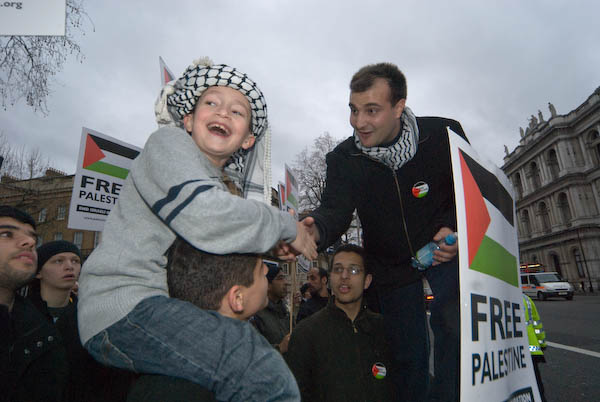
Congratulations to a young demonstrator who took a
turn at leading the chanting.
more pictures
After events in Gaza in recent days in which Israeli attacks have
killed 115 Palestinians and wounded 350, the British Muslim initiative,
Palestine Solidarity Campaign, Palestinian Forum in Britain and
Palestine Return Centre called for an emergency demonstration opposite
Downing St on Saturday afternoon.
Pictures copyright © 2008, Peter Marshall. All rights reserved.
Despite very short notice, there were still over a hundred supporters
present when I arrived rather late – quite a few had already gone home.
more pictures
The Zimbabwe Vigil
Zimbabwe Embassy, Strand, London. March 8, 2008
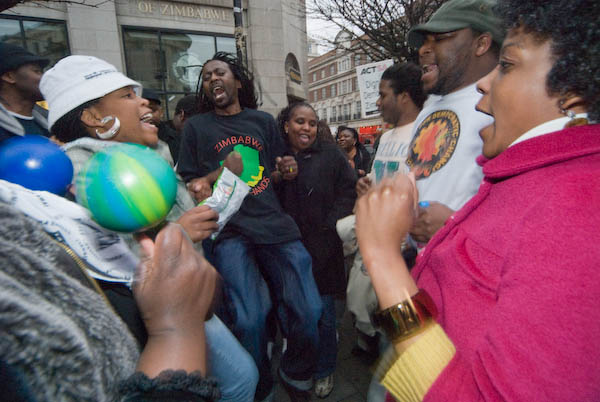
Dancing at the Zimbabwe Embassy on the Strand
more pictures
Every Saturday afternoon since 12 October 2002, the Zimbabwe Vigil
outside the Zimbabwe Embassy in the Strand, London has protested against
human rights violations in Zimbabwe.
Those concerned also stage other events as well as lobbying Parliament
and other bodies to end Mugabe's madness.
more pictures
SERCO picket - Close Yarl's Wood
Hand Court, High Holborn, London. March 8, 2008
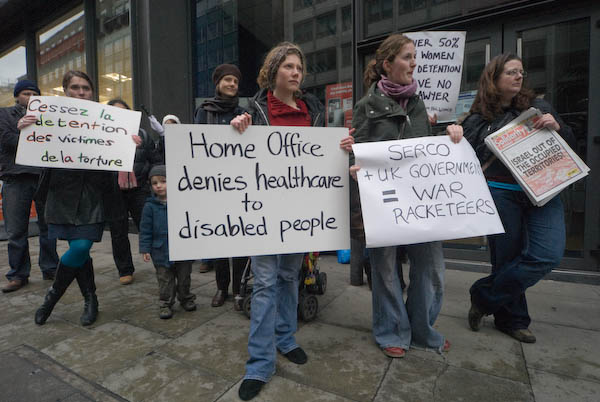
After meeting outside the SERCO office the picket
formed up on High Holborn
more pictures
As a part of the International Women's Day, Feminist Fightback, All
African Women’s Group and Black Women’s Rape Action Project picketed the
SERCO
Research Institute in central London, demanding the immediate closure of
Yarl’s Wood Immigration Removal Centre.
SERCO may be a name that most people would not recognise, though
increasingly around the world it is running their lives. Around the
world, governments are turning to SERCO to run what used to be public
services - hospitals, prisons, schools and even military services. In
the UK, if you go to prison it may be run by SERCO, and you will be
taken there in a SERCO van. They own and run Yarl's Wood Immigration
Removal Centre, where around 400 women and children seeking asylum are
imprisoned.
Around 70% of the women there at any time claim they are survivors of
rape. Conditions at Yarl's Wood are appalling, with inadequate food,
racist and sexist abuse, and profiteering from the sale of essential
items, (and SERCO were forced to investigate why they were no receiving
their miniscule government allowance of 71p a day.) At times women have
been prevented from contacting their lawyers.
Women there have responded with hunger strikes as well as letters and
petitions to Gordon Brown and others demanding investigation of their
treatment.
SERCO have a Research Institute in a court off High Holborn, and as a
part of the International Women's Day, Feminist Fightback, All African
Women’s Group and Black Women’s Rape Action Project held a picket there
after the Million Women Rise event on Saturday March 8.
Around 40 people turned up to demand the immediate closure of Yarl's
Wood and an end to the criminalisation of rape and torture survivors.
They also called for an end to SERCO and other private companies
profiting from the oppression and misery of others.
more pictures
Million Women Rise: International Women's Day March
Hyde Park to Trafalgar Square, London. March 8, 2008
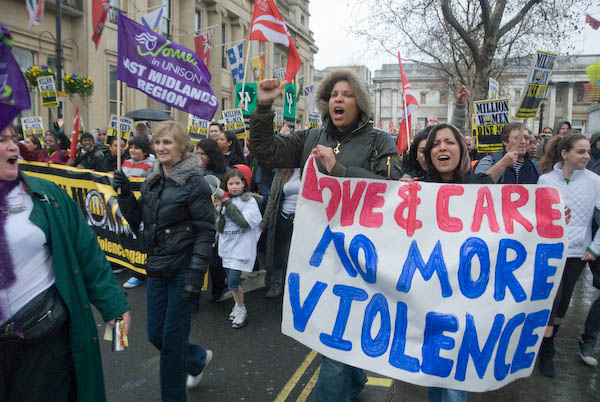
The march reaches Trafalgar Square
more pictures
This all-woman march was aimed against all forms of male violence
against women, and supported by women from a very wide range of groups,
including trade unions and political organisations, rape support groups,
feminist groups, sex workers, the women's international league for peace
and freedom, the women's network of the international action network on
small arms, Kurdish women and the women's institute.
I arrived just in time for the start of the march promptly at 1pm when
several thousand women (my estimate was 2,500) made their way out of
Hyde Park and onto Park Lane. Dedicated to the dignity of women across
the world, the main banner at its head read ‘Million Women Rise –
together we can end violence against women….
As well as placards, banners and T-shirts from a number of
organisations, there were also many women carrying hand-made placards
with obviously very strongly personally felt statements against male
violence.
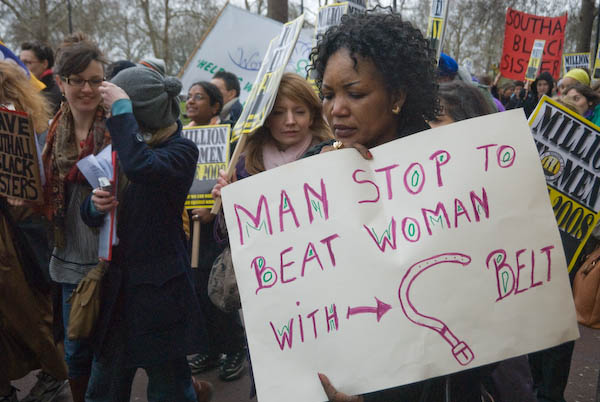
This was an all-women march and I had to work from the sidelines rather
than pitch in and take part as I usually try to do. The police had also
responded with an unusually high proportion of women officers, although
their presence was hardly required other than for traffic control. The
only incident with police I saw during the march was an argument with a
woman standing on a roadside box taking pictures of the march who
ignored their requests to come down.
I left Trafalgar Squares as the rally started, needing a rest (and, as it
happened, a Shropshire Lass, a rather pleasant blonde bitter.) Later I was
dismayed to hear that at least one of those expected to speak had been
prevented from addressing the rally after the organisers had read her
draft text.
more pictures
Rally for Dignity and Democracy in Zimbabwe
Trafalgar Square, London. March 8, 2008
 Diana
Holland on screen, other speakers including TUC General Secretary
Brendan Barber wait their turn.
Diana
Holland on screen, other speakers including TUC General Secretary
Brendan Barber wait their turn.
more pictures
The Dignity! Period campaign was launched by ACTSA in 2005 in
solidarity with the Zimbabwe Congress of Trade Unions (ZCTU) and
supported by the UK trade union movement and a number of celebrities. It
offers very practical support to the women of Zimbabwe, where inflation
has made sanitary products prohibitively expensive. Since its start the
campaign has distributed more than 3 million sanitary pads, enabling
women and girls in Zimbabwe to continue work and education without the
risk to their health from using newspapers and dirty rags.
The Zimbabwe government has reneged on its promise not to collect
import duties on the pads, and the campaign is now working through the
only remaining local manufacturer of these products to avoid paying this
tax.
Although ACTSA had hoped for thousands to attend this rally on
International Women’s Day, there were only around a hundred when I left
at around 12.45 to rush to the Million Women Rise march starting in Hyde
Park. Probably many of those who might have attended had already
gathered there, as the start of the rally was unfortunately timed to
coincide with the assembly time of the march.
This was unfortunate, as there were some interesting speakers both from
Zimbabwe and the UK trade unions - the latter including Diana Holland,
Unite national organiser for women, race and equalities and TUC General
Secretary Brendan Barber, both of whom spoke before I had to leave.
more pictures
Tibetan Uprising Day
Chinese Embassy - Whitehall, London 8 March 2008
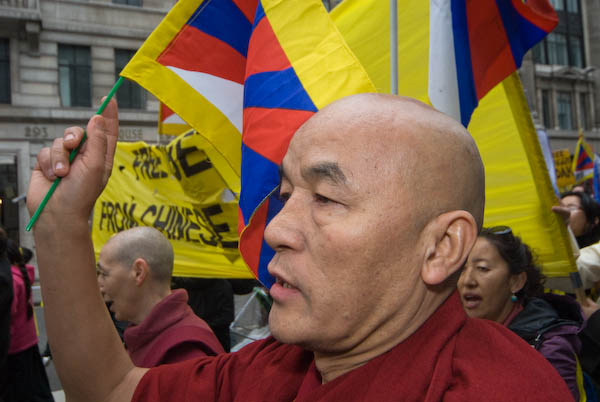
Tibetan monks and former nuns were among those demanding freedom and
an end to human rights abuses in Tibet.
Around a thousand marched from the Chinese Embassy to a Whitehall rally
to remember the Tibetan uprising 49 years ago and to demand that Gordon
Brown meet the Dalai Lama and end British silence over Chinese human
rights abuses in Tibet. The event started with a demonstration opposite
the Chinese embassy in Portland Place, and a small deputation -
including two men in a yak costume went across the road to attempt to
deliver a message to the Chinese embassy.
Police stopped the yak in the refuge in the centre of the road, and for
a while it looked as if they would not allow it to approach the embassy,
but eventually decided it didn't present a major security hazard and
allowed it to proceed.
Soon after the march set off through London's west end to Whitehall,
catching attention with its colour and noise, and many of the shoppers
and tourists waved in support.
The march marked the 49th anniversary of March 10, 1959, when Tibetans
rose up against the Chinese who had occupied their country since 1950.
Tens of thousands of Tibetans were killed following the uprising
(estimates put the total killed since 1950 as 1.2 million) and the
Chinese tightened their already repressive regime.
The march was led by several former Tibetan nuns who were imprisoned
and tortured in Tibet. As well as asking the British government to
support its campaign for human rights, demonstrators demanded the
release of the 11th Panchen Lama, kidnapped by the Chinese when 6 years
old in 1995.
My heart goes out to the people of Tibet, although my head tells me
that there is little chance of freedom for their country in the
foreseeable future. But perhaps as China matures as a nation, things
will change.
One cyclist taking part was warned by police who felt he was putting
other demonstrators at risk. When he refused to dismount they pulled him
to the side of the road and threatened him with arrest. Otherwise I saw
no incidents.
I left before the rally in Palace Street at the end of the march to go
to another demonstration.
more pictures
Procession of Arbaeen
Marble Arch, London. Sunday 2 March, 2008
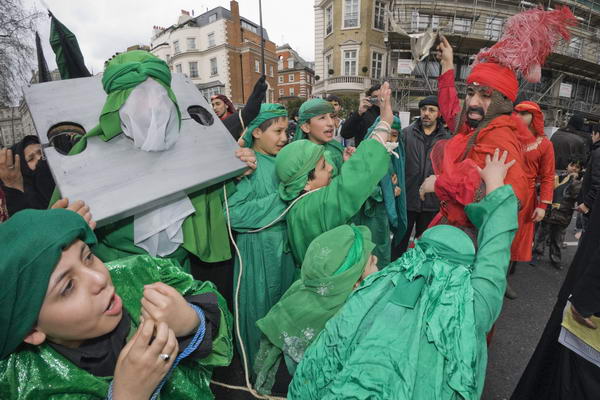
The procession on Park Lane
more pictures
Shia Muslims regard the massacre of the prophet Mohammed's grandson,
together with 72 companions at Karbala as "the greatest sacrifice make
by mankind, for humanity" and the "ultimate standoff between 'good and
evil'. Hussain had refused to pledge allegiance to the ruler - "Death
in honour is preferable to life in humiliation" - and his small
band of followers fought to the death against an army of 40,000.
Following the massacre the women and children who had been travelling
with Imam Hussain were taken captive and paraded through towns and
cities on a 750 mile journey to Damascus, along with the decapitated
heads of the martyrs, impaled on spears.
The Arbaeen procession marks the end of the annual 40 days of mourning,
and similar processions take place in cities around the world. There are
reenactments of some of the events, prayers of mourning, and expression
of grief in various ways including the beating of breasts.
more pictures
Freedom to Protest 2
Westminster, London 1 Mar, 2008
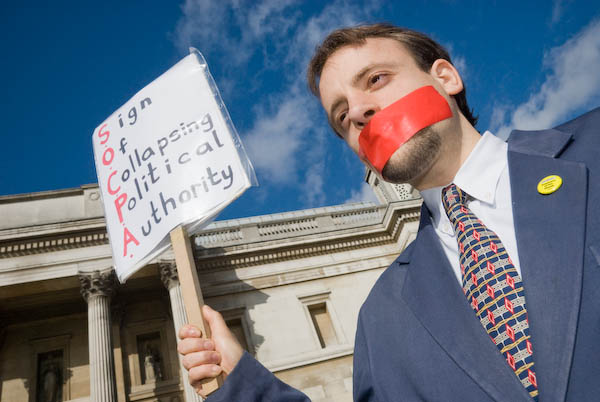
SOCPA placard outside the National Gallery
more pictures
Police were obviously determined not to be caught on the hop again
after the Freedom to Protest event
in January, and there were hundreds if not thousands of additional
officers on duty throughout Westminster for the second 'Freedom to
Protest' demonstration on Saturday 1 March. In Trafalgar Square
where the event was due to begin, there were perhaps 50 officers when I
arrived half an hour before it was due to start, and I'd already passed
extra police on duty outside Downing St, with a further large number
spread out in Parliament Square and surrounding areas, and later I found
more around the Home Office.
While the police had put on such a splendid turn-out, demonstrators had
clearly decided to stay at home, or at least to celebrate St David's Day
elsewhere, with only a small group of perhaps 50 turning up to the
square, where they were heavily outnumbered by police.
An officer came up to a small group and warned them that any
demonstration in the SOCPA designated area would be illegal, handing out
a few notices while one of the demonstrators took notes and a police
photographer kept busy photographing those present. Later the
photographer objected to demonstrators photographing him and several
times pushed out his arm in a unfortunate gesture resembling a Nazi
salute, at one point hitting one of the demonstrators in the throat.
Later this photographer was chased by a 'serious criminal' offering her
'Illegali-Tea' and was so harassed that he took refuge by running up the
stairs of the National Gallery.
A small group of the demonstrators decided to walk towards Parliament
Square and were followed by police. One young man who managed to evade
the police (but not several press photographers) was later stopped by
police opposite Downing St and searched, but the most suspicious thing
found on him was a strong Newcastle accent. Although through most of the
event police behaved impeccably toward the press, one officer here
ordered me away from the scene quite unnecessarily, although others
continued to behave more reasonably.
I went and photographed the continuing peace protest in Parliament
Square, where one protester was making a rather splendid chalk pavement
drawing. While I was watching her a police van drew up and it looked as
if she was about to be apprehended, but seeing several photographers
present, the van drove off.
Later a small group of protesters walked though the area followed by
the press and police, making their way to a pub on the Horseferry Road,
and causing a little consternation among police around the Home Office.
But they went into the pub and police and press went home
more pictures
top of page
All pictures on this section of the site are ©
Peter Marshall 2008; to buy prints or for permission to reproduce
pictures or to comment on this site, or for any other questions,
contact me.




























